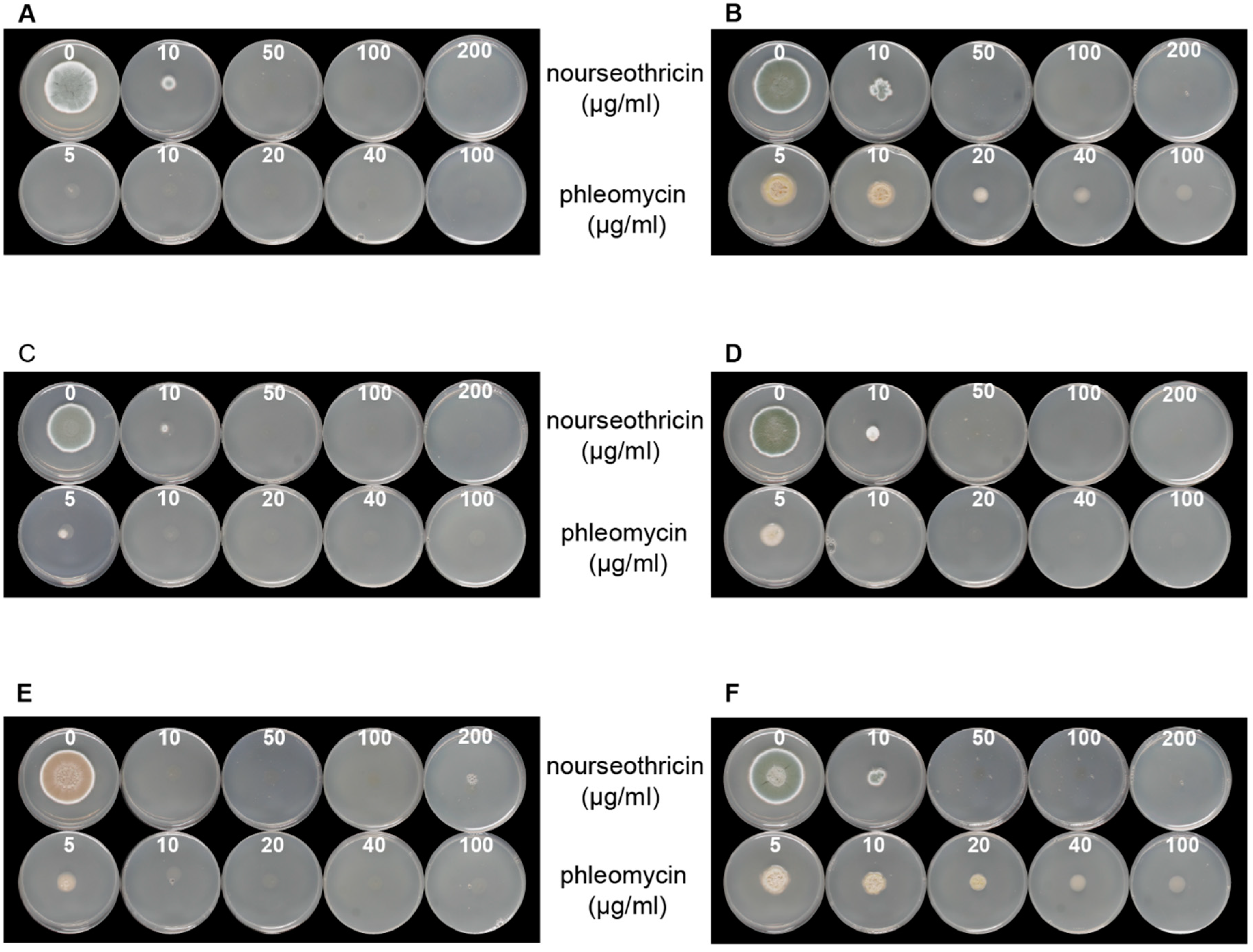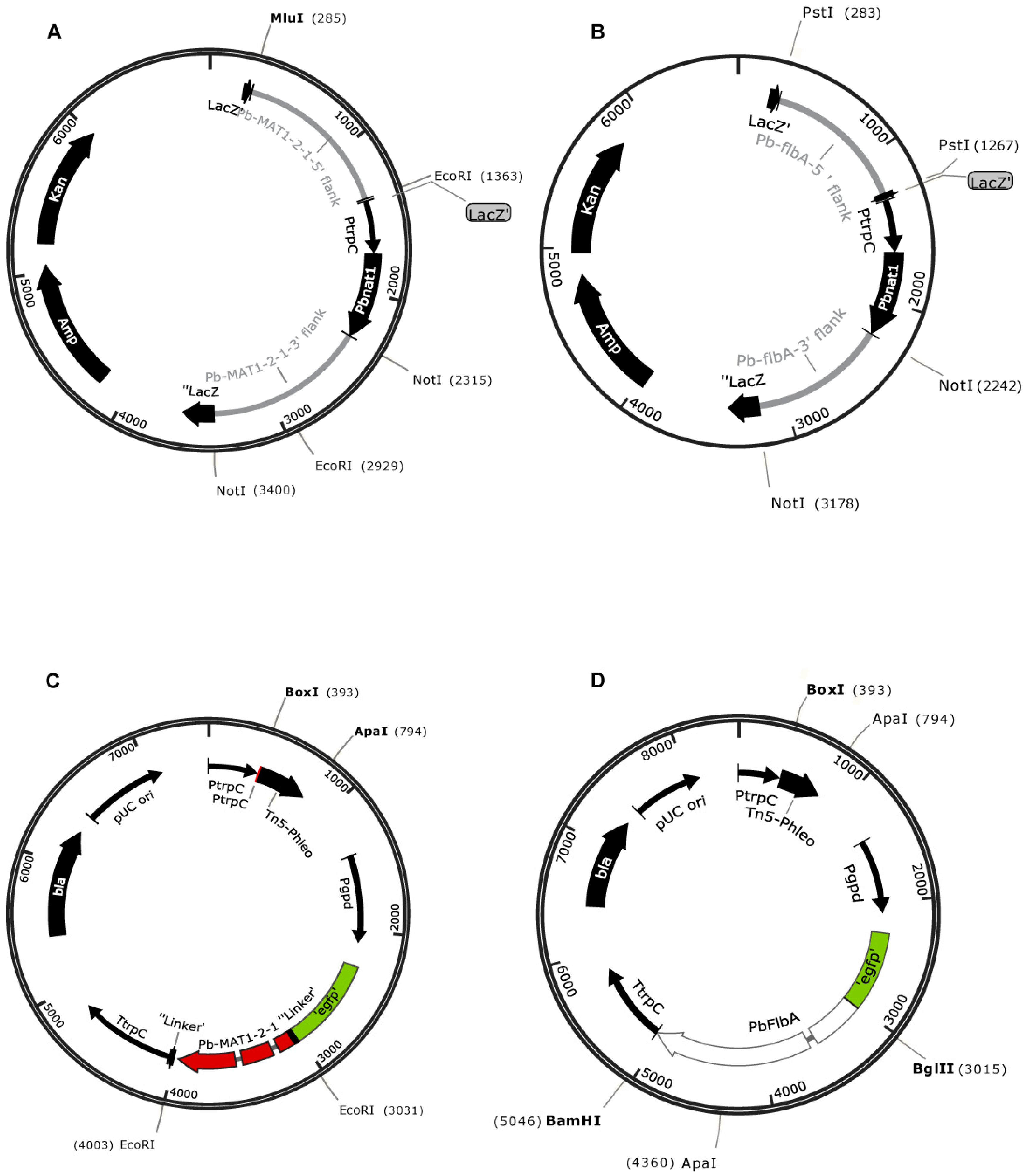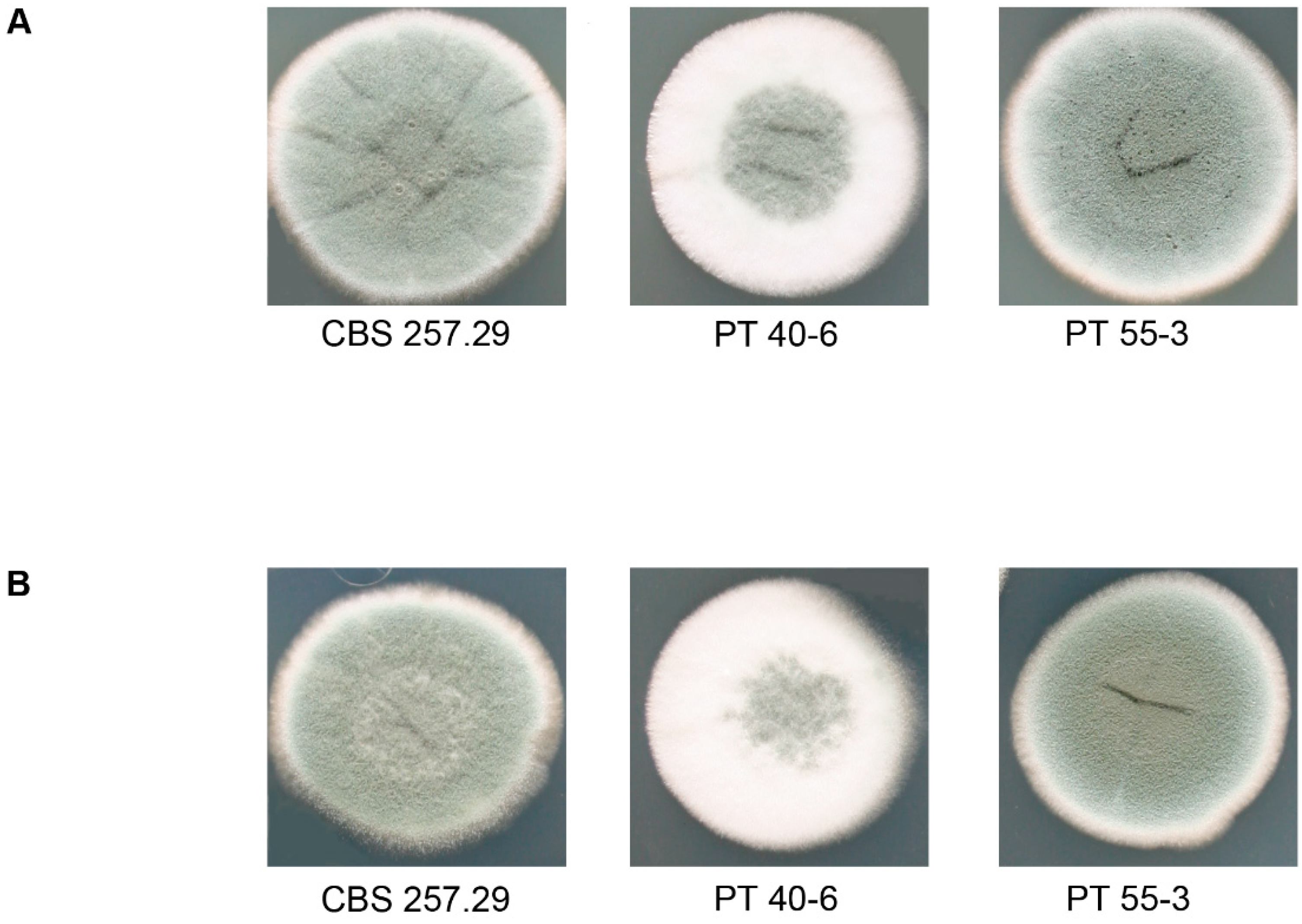Construction of a Codon-Adapted Nourseotricin-Resistance Marker Gene for Efficient Targeted Gene Deletion in the Mycophenolic Acid Producer Penicillium brevicompactum
Abstract
1. Introduction
2. Material and Methods
2.1. Strains, Plasmids and Culture Conditions
2.2. Construction of Transformation Vectors
2.3. Bioinformatics and Programs
2.4. Transformation of P. brevicompactum Strains
3. Results and Discussion
3.1. Test for Sensitivity Against Antibiotics and DNA Transformation
3.2. Construction of a Codon-Adapted nat1 Gene
3.3. Use of the Codon-Optimized Pbnat1 Gene for Site-Specific Deletion of Two Nuclear Genes
Supplementary Materials
Author Contributions
Funding
Acknowledgement
Conflicts of Interest
References
- Kluge, J.; Terfehr, D.; Kück, U. Inducible promoters and functional genomic approaches for the genetic engineering of filamentous fungi. Appl. Microbiol. Biotechnol. 2018, 102, 6357–6372. [Google Scholar] [CrossRef] [PubMed]
- He, Z.M.; Price, M.S.; Obrian, G.R.; Georgianna, D.R.; Payne, G.A. Improved protocols for functional analysis in the pathogenic fungus Aspergillus flavus. BMC Microbiol. 2007, 7, 104. [Google Scholar] [CrossRef] [PubMed]
- Ruiz-Diez, B. Strategies for the transformation of filamentous fungi. J. Appl. Microbiol. 2002, 92, 189–195. [Google Scholar] [CrossRef] [PubMed]
- Michielse, C.B.; Arentshorst, M.; Ram, A.F.; van den Hondel, C.A. Agrobacterium-mediated transformation leads to improved gene replacement efficiency in Aspergillus awamori. Fungal Genet. Biol. 2005, 42, 9–19. [Google Scholar] [CrossRef] [PubMed]
- Weld, R.J.; Plummer, K.M.; Carpenter, M.A.; Ridgway, H.J. Approaches to functional genomics in filamentous fungi. Cell Res. 2006, 16, 31–44. [Google Scholar] [CrossRef] [PubMed]
- Kück, U.; Hoff, B. New tools for the genetic manipulation of filamentous fungi. Appl. Microbiol. Biotechnol. 2010, 86, 51–62. [Google Scholar] [CrossRef]
- Krappmann, S. CRISPR-Cas9, the new kid on the block of fungal molecular biology. Med. Mycol. 2017, 55, 16–23. [Google Scholar] [CrossRef]
- Shi, T.Q.; Liu, G.N.; Ji, R.Y.; Shi, K.; Song, P.; Ren, L.J.; Huang, H.; Ji, X.J. CRISPR/Cas9-based genome editing of the filamentous fungi: The state of the art. Appl. Microbiol. Biotechnol. 2017, 101, 7435–7443. [Google Scholar] [CrossRef]
- Austin, B.; Hall, R.M.; Tyler, B.M. Optimized vectors and selection for transformation of Neurospora crassa and Aspergillus nidulans to bleomycin and phleomycin resistance. Gene 1990, 93, 157–162. [Google Scholar] [CrossRef]
- Jiang, D.; Zhu, W.; Wang, Y.; Sun, C.; Zhang, K.Q.; Yang, J. Molecular tools for functional genomics in filamentous fungi: Recent advances and new strategies. Biotechnol. Adv. 2013, 31, 1562–1574. [Google Scholar] [CrossRef]
- Bentley, R. Mycophenolic Acid: A one hundred year odyssey from antibiotic to immunosuppressant. Chem. Rev. 2000, 100, 3801–3826. [Google Scholar] [CrossRef] [PubMed]
- Zhang, W.; Cao, S.; Qiu, L.; Qi, F.; Li, Z.; Yang, Y.; Huang, S.; Bai, F.; Liu, C.; Wan, X.; et al. Functional characterization of MpaG’, the O-methyltransferase involved in the biosynthesis of mycophenolic acid. Chembiochem 2015, 16, 565–569. [Google Scholar] [CrossRef] [PubMed]
- Regueira, T.B.; Kildegaard, K.R.; Hansen, B.G.; Mortensen, U.H.; Hertweck, C.; Nielsen, J. Molecular basis for mycophenolic acid biosynthesis in Penicillium brevicompactum. Appl. Environ. Microbiol. 2011, 77, 3035–3043. [Google Scholar] [CrossRef] [PubMed]
- Varavallo, M.A.; de Queiroz, M.V.; Pereira, J.F.; Ribeiro, R.A.; Soares, M.A.; Ribeiro, J.B.; de Araujo, E.F. Development of a transformation system for Penicillium brevicompactum based on the Fusarium oxysporum nitrate reductase gene. Braz. J. Microbiol. 2005, 36, 184–189. [Google Scholar] [CrossRef]
- Dong, Y.; Zhang, J.; Xu, R.; Lv, X.; Wang, L.; Sun, A.; Wei, D. Insertion mutation in HMG-CoA lyase increases the production yield of MPA through Agrobacterium tumefaciens-mediated transformation. J. Microbiol. Biotechnol. 2016, 26, 1924–1932. [Google Scholar] [CrossRef] [PubMed]
- Kolar, M.; Punt, P.J.; Vandenhondel, C.A.M.J.J.; Schwab, H. Transformation of Penicillium chrysogenum using dominant selection markers and expression of an Escherichia coli LacZ fusion gene. Gene 1988, 62, 127–134. [Google Scholar] [CrossRef]
- Böhm, J.; Dahlmann, T.A.; Gümüser, H.; Kück, U. A MAT1-2 wild-type strain from Penicillium chrysogenum: Functional mating-type locus characterization, genome sequencing and mating with an industrial penicillin-producing strain. Mol. Microbiol. 2015, 95, 859–874. [Google Scholar] [CrossRef]
- Kück, U.; Hoff, B. Application of the nourseothricin acetyltransferase gene (nat1) as dominant marker for the transformation of filamentous fungi. Fungal Genet. Newsl. 2006, 53, 9–11. [Google Scholar] [CrossRef]
- Kopke, K.; Hoff, B.; Kück, U. Application of the Saccharomyces cerevisiae FLP/FRT recombination system in filamentous fungi for marker recycling and construction of knockout strains devoid of heterologous genes. Appl. Environ. Microbiol. 2010, 76, 4664–4674. [Google Scholar] [CrossRef]
- Visagie, C.M.; Houbraken, J.; Frisvad, J.C.; Hong, S.B.; Klaassen, C.H.; Perrone, G.; Seifert, K.A.; Varga, J.; Yaguchi, T.; Samson, R.A. Identification and nomenclature of the genus Penicillium. Stud. Mycol. 2014, 78, 343–371. [Google Scholar] [CrossRef]
- Böhm, J.; Hoff, B.; O’Gorman, C.M.; Wolfers, S.; Klix, V.; Binger, D.; Zadra, I.; Kurnsteiner, H.; Poggeler, S.; Dyer, P.S.; et al. Sexual reproduction and mating-type-mediated strain development in the penicillin-producing fungus Penicillium chrysogenum. Proc. Natl. Acad. Sci. USA 2013, 110, 1476–1481. [Google Scholar] [CrossRef] [PubMed]
- Sambrook, J.R.; Green, M.R. Molecular Cloning: A Laboratory Manual; Cold Spring Harbor Laboratory Press: Cold Spring Harbor, NY, USA, 2001. [Google Scholar]
- Kück, U.; Pöggeler, S.; Nowrousian, M.; Nolting, N.; Engh, I. Sordaria macrospora, a model system for fungal development. In Physiology and Genetics: Selected Basic and Applied Aspects; Anke, T., Weber, D., Eds.; Springer: Berlin/Heidelberg, Germany, 2009; pp. 17–39. [Google Scholar]
- Puigbò, P.; Bravo, I.G.; Garcia-Vallve, S. CAIcal: A combined set of tools to assess codon usage adaptation. Biol. Direct 2008, 3, 38. [Google Scholar] [CrossRef] [PubMed]
- Bull, J.H.; Smith, D.J.; Turner, G. Transformation of Penicillium chrysogenum with a dominant selectable marker. Curr. Genet. 1988, 13, 377–382. [Google Scholar] [CrossRef] [PubMed]
- Hoff, B.; Kamerewerd, J.; Sigl, C.; Zadra, I.; Kück, U. Homologous recombination in the antibiotic producer Penicillium chrysogenum: Strain DeltaPcku70 shows up-regulation of genes from the HOG pathway. Appl. Microbiol. Biotechnol. 2010, 85, 1081–1094. [Google Scholar] [CrossRef] [PubMed]
- Gesing, S.; Schindler, D.; Franzel, B.; Wolters, D.; Nowrousian, M. The histone chaperone ASF1 is essential for sexual development in the filamentous fungus Sordaria macrospora. Mol. Microbiol. 2012, 84, 748–765. [Google Scholar] [CrossRef] [PubMed]
- Mahmoudjanlou, Y.; Dahlmann, T.; Kück, U. Molecular analysis of mating type genes in the mycophenolic acid producer Penicillium brevicompactum. 2019; in preparation. [Google Scholar]
- Gooch, V.D.; Mehra, A.; Larrondo, L.F.; Fox, J.; Touroutoutoudis, M.; Loros, J.J.; Dunlap, J.C. Fully codon-optimized luciferase uncovers novel temperature characteristics of the Neurospora clock. Eukaryot. Cell 2008, 7, 28–37. [Google Scholar] [CrossRef] [PubMed]
- Tokuoka, M.; Tanaka, M.; Ono, K.; Takagi, S.; Shintani, T.; Gomi, K. Codon optimization increases steady-state mRNA levels in Aspergillus oryzae heterologous gene expression. Appl. Environ. Microbiol. 2008, 74, 6538–6546. [Google Scholar] [CrossRef] [PubMed]
- Zhou, Z.; Dang, Y.; Zhou, M.; Li, L.; Yu, C.H.; Fu, J.; Chen, S.; Liu, Y. Codon usage is an important determinant of gene expression levels largely through its effects on transcription. Proc. Natl. Acad. Sci. USA 2016, 113, E6117–E6125. [Google Scholar] [CrossRef]
- Sharp, P.M.; Li, W.H. The codon Adaptation Index—a measure of directional synonymous codon usage bias, and its potential applications. Nucleic Acids Res. 1987, 15, 1281–1295. [Google Scholar] [CrossRef]
- Quax, T.E.; Claassens, N.J.; Soll, D.; van der Oost, J. Codon bias as a means to fine-tune gene expression. Mol. Cell 2015, 59, 149–161. [Google Scholar] [CrossRef]
- Yu, J.H.; Wieser, J.; Adams, T.H. The Aspergillus FlbA RGS domain protein antagonizes G protein signaling to block proliferation and allow development. EMBO J. 1996, 15, 5184–5190. [Google Scholar] [CrossRef] [PubMed]
- Becker, K.; Beer, C.; Freitag, M.; Kück, U. Genome-wide identification of target genes of a mating-type-domain transcription factor reveals functions beyond sexual development. Mol. Microbiol. 2015, 96, 1002–1022. [Google Scholar] [CrossRef] [PubMed]
- Seo, J.A.; Yu, J.H. The phosducin-like protein PhnA is required for Gbetagamma-mediated signaling for vegetative growth, developmental control, and toxin biosynthesis in Aspergillus nidulans. Eukaryot. Cell 2006, 5, 400–410. [Google Scholar] [CrossRef] [PubMed]
- Aerts, D.; Hauer, E.E.; Ohm, R.A.; Arentshorst, M.; Teertstra, W.R.; Phippen, C.; Ram, A.F.J.; Frisvad, J.C.; Wosten, H.A.B. The FlbA-regulated predicted transcription factor Fum21 of Aspergillus niger is involved in fumonisin production. Antonie Van Leeuwenhoek 2018, 111, 311–322. [Google Scholar] [CrossRef] [PubMed]
- Ninomiya, Y.; Suzuki, K.; Ishii, C.; Inoue, H. Highly efficient gene replacements in Neurospora strains deficient for nonhomologous end-joining. Proc. Natl. Acad. Sci. USA 2004, 101, 12248–12253. [Google Scholar] [CrossRef]
- Walker, J.R.; Corpina, R.A.; Goldberg, J. Structure of the Ku heterodimer bound to DNA and its implications for double-strand break repair. Nature 2001, 412, 607–614. [Google Scholar] [CrossRef]
- Krappmann, S. Gene targeting in filamentous fungi: The benefits of impaired repair. Fungal Biol. Rev. 2007, 21, 25–29. [Google Scholar] [CrossRef]
- Siewers, V.; Kokkelink, L.; Smedsgaard, J.; Tudzynski, P. Identification of an abscisic acid gene cluster in the grey mold Botrytis cinerea. Appl. Environ. Microbiol. 2006, 72, 4619–4626. [Google Scholar] [CrossRef]
- Lin, C.H.; Chung, K.R. Specialized and shared functions of the histidine kinase- and HOG1 MAP kinase-mediated signaling pathways in Alternaria alternata, a filamentous fungal pathogen of citrus. Fungal Genet. Biol. 2010, 47, 818–827. [Google Scholar] [CrossRef]
- Lou, H.; Ye, Z.; Yun, F.; Lin, J.; Guo, L.; Chen, B.; Mu, Z. Targeted gene deletion in Cordyceps militaris using the split-marker approach. Mol. Biotechnol. 2018, 60, 380–385. [Google Scholar] [CrossRef]




| Strain | Characteristics, Genotype | Source |
|---|---|---|
| CBS 257.29 | Wild type, neotype of P. brevicompactum Dierckx | (1) |
| CBS 317.59 | Wild type | (1) |
| CBS 110068 | Wild type | (1) |
| CBS 110070 | Wild type | (1) |
| CBS 110071 | Wild type | (1) |
| IBT 23078 | Wild type | (2) [13] |
| ∆PbMAT1-2-1 | MAT1-2-1Δ::ptrpC::Pbnat1; recipient: CBS 110068 | This study |
| ∆PbflbA | flbAΔ::ptrpC::Pbnat1; recipient: CBS 257.29 | This study |
| ∆PbMAT1-2-1::PbMAT1-2-1 | pgpd::egfp::PbMAT1-2-1:ptrpC::phle | This study |
| ∆PbflbA::PbflbA | pgpd::egfp::PbflbA:ptrpC::phle | This study |
| T | C | A | G | ||||||||||||||
|---|---|---|---|---|---|---|---|---|---|---|---|---|---|---|---|---|---|
| nat1 | Pb | Pb | nat1 | Pb | Pb | nat1 | Pb | Pb | nat1 | Pb | P.b | ||||||
| nat1 | nat1 | nat1 | nat1 | ||||||||||||||
| T | Phe | 0 | 37.5 | 32.47 | Ser | 0 | 33.3 | 19 | Tyr | 0 | 28.6 | 40.7 | Cys | 0 | 0 | 43.2 | T |
| Phe | 100 | 62.5 | 67.53 | Ser | 33.3 | 44.5 | 21.6 | Tyr | 100 | 71.4 | 59.3 | Cys | 100 | 100 | 56.8 | C | |
| Leu | 0 | 0 | 4.9 | Ser | 0 | 0 | 15.2 | Stop | 0 | 0 | 31.8 | Stop | 0 | 0 | 45.5 | A | |
| Leu | 7.1 | 0 | 19.4 | Ser | 44.4 | 0 | 14.9 | Stop | 0 | 0 | 22.7 | Trp | 100 | 100 | 100 | G | |
| C | Leu | 0 | 0 | 19.7 | Pro | 0 | 30 | 26.1 | His | 0 | 25 | 44.2 | Arg | 0 | 15.4 | 18.6 | T |
| Leu | 38.4 | 57.1 | 25.5 | Pro | 40 | 70 | 30 | His | 100 | 75 | 55.8 | Arg | 38.5 | 0 | 29.7 | C | |
| Leu | 0 | 0 | 8.4 | Pro | 0 | 0 | 25.3 | Gln | 0 | 0 | 45.8 | Arg | 0 | 0 | 19 | A | |
| Leu | 61.6 | 42.9 | 22.1 | Pro | 60 | 0 | 18.6 | Gln | 100 | 100 | 54.2 | Arg | 61.5 | 0 | 13.6 | G | |
| A | Ile | 0 | 33.3 | 36.5 | Thr | 0 | 0 | 25.1 | Asn | 0 | 33,3 | 40.5 | Ser | 11.15 | 0 | 11.7 | T |
| Ile | 100 | 66.7 | 52.7 | Thr | 82.4 | 70.6 | 35.7 | Asn | 100 | 66,7 | 59.5 | Ser | 11.15 | 22.3 | 17.6 | C | |
| Ile | 0 | 0 | 10.8 | Thr | 0 | 0 | 23.7 | Lys | 0 | 0 | 34.1 | Arg | 0 | 0 | 11.3 | A | |
| Met | 100 | 100 | 100 | Thr | 17.6 | 29.4 | 15.5 | Lys | 100 | 100 | 65.9 | Arg | 0 | 0 | 7.8 | G | |
| G | Val | 0 | 33.3 | 27.2 | Ala | 5.3 | 31.6 | 27.5 | Asp | 4.4 | 47.8 | 51.8 | Gly | 0 | 30 | 29 | T |
| Val | 73.3 | 53.3 | 37.1 | Ala | 47.5 | 68.4 | 32.8 | Asp | 95.6 | 52.2 | 48.2 | Gly | 45 | 70 | 32.7 | C | |
| Val | 0 | 0 | 8.6 | Ala | 10.4 | 0 | 22 | Glu | 15.4 | 30.7 | 42.8 | Gly | 0 | 0 | 24.8 | A | |
| Val | 26.7 | 13.4 | 27.1 | Ala | 36.8 | 0 | 17.7 | Glu | 84.6 | 69.3 | 57.2 | Gly | 52.4 | 0 | 13.5 | G | |
© 2019 by the authors. Licensee MDPI, Basel, Switzerland. This article is an open access article distributed under the terms and conditions of the Creative Commons Attribution (CC BY) license (http://creativecommons.org/licenses/by/4.0/).
Share and Cite
Mahmoudjanlou, Y.; Hoff, B.; Kück, U. Construction of a Codon-Adapted Nourseotricin-Resistance Marker Gene for Efficient Targeted Gene Deletion in the Mycophenolic Acid Producer Penicillium brevicompactum. J. Fungi 2019, 5, 96. https://doi.org/10.3390/jof5040096
Mahmoudjanlou Y, Hoff B, Kück U. Construction of a Codon-Adapted Nourseotricin-Resistance Marker Gene for Efficient Targeted Gene Deletion in the Mycophenolic Acid Producer Penicillium brevicompactum. Journal of Fungi. 2019; 5(4):96. https://doi.org/10.3390/jof5040096
Chicago/Turabian StyleMahmoudjanlou, Yasaman, Birgit Hoff, and Ulrich Kück. 2019. "Construction of a Codon-Adapted Nourseotricin-Resistance Marker Gene for Efficient Targeted Gene Deletion in the Mycophenolic Acid Producer Penicillium brevicompactum" Journal of Fungi 5, no. 4: 96. https://doi.org/10.3390/jof5040096
APA StyleMahmoudjanlou, Y., Hoff, B., & Kück, U. (2019). Construction of a Codon-Adapted Nourseotricin-Resistance Marker Gene for Efficient Targeted Gene Deletion in the Mycophenolic Acid Producer Penicillium brevicompactum. Journal of Fungi, 5(4), 96. https://doi.org/10.3390/jof5040096





